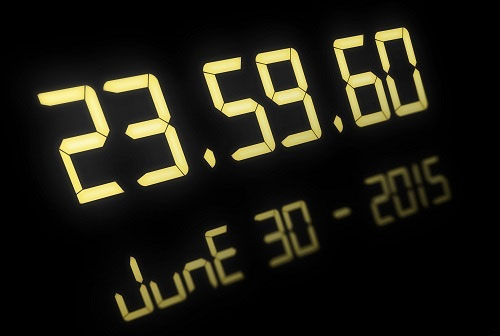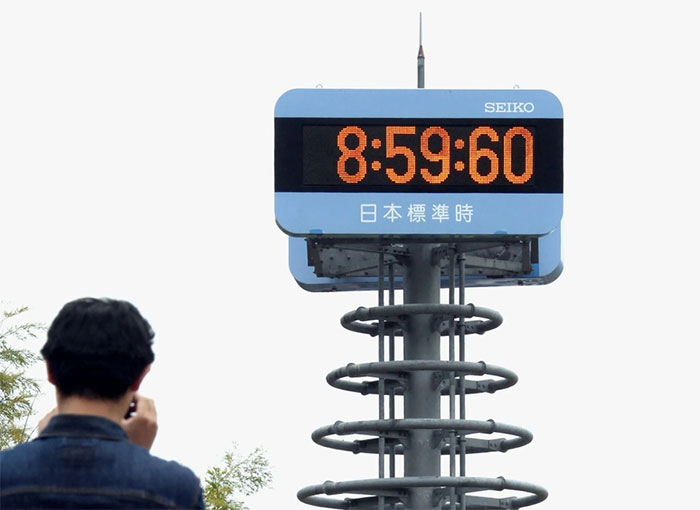A leap second will help clocks worldwide synchronize with the Earth’s rotation, but it also causes errors in computer systems and software.
For the past half-century, leap seconds have been added to Coordinated Universal Time (UTC) to keep time in sync with the Earth’s rotation. However, in a few years, leap seconds will officially be eliminated from the world’s history.
This change will resolve a long-standing issue that has plagued many technology companies, as computers and software systems have struggled to handle the anomaly of a minute containing 61 seconds.

Tech companies also want to eliminate leap seconds due to issues with computer systems. (Photo: GNSS).
A New Future for International Time
According to Cnet, during a meeting at the International Bureau of Weights and Measures (BIPM) on November 18, organizations measuring time worldwide decided to abolish leap seconds.
“The introduction of leap seconds has caused many problems, leading to malfunctions in digital devices that cannot process data, such as satellite positioning systems, telecommunications, or energy transmission,” a BIPM representative explained.
This change will officially take effect no later than 2035.

An additional second added to clocks has caused many websites to malfunction. (Photo: NASA).
“It’s hard to believe. After more than 20 years of discussion, we have finally reached an official agreement,” said Patrizia Tavella, Director of Time Management at BIPM. Elizabeth Donley, Director of the Time and Frequency Measurement Division at the National Institute of Standards and Technology (NIST), remarked that this is a historic moment for humanity.
According to the New York Times, the Earth does not rotate at a steady pace. To keep clock time aligned with the Earth’s movement, especially for astronomers needing precise observations, leap seconds have been added as necessary.
Since 1972, leap seconds have been added a total of 27 times. Unlike leap years, leap seconds are added simultaneously worldwide, with the most recent addition occurring at the last second of December 31, 2016, according to Coordinated Universal Time (UTC).
At 11:59:59 PM on June 30 or December 31, the UTC clock will add a second, making it 11:59:60 PM instead of rolling over to 12:00:00 AM the following day. This helps keep the UTC’s deviation from Universal Time (UT1), which is measured based on the Earth’s rotation, within 0.9 seconds.
“Computational Disasters” Due to the 61st Second
However, leap seconds have been a headache for the tech industry for the past five decades. It is difficult to predict when the next leap second will need to be added. As a result, networks of machines cannot prepare for this change in advance. Instead, each network has its own method for adding the 61st second to the clock, leading to a lack of synchronization.
Modern machinery operates based on a super-precise time management network, accurate to the millisecond. They are accustomed to using clocks without leap seconds to schedule pre-timed activities, such as software updates or data uploads.
Thus, the addition of a leap second can cause telecommunications systems, energy transmission, financial transactions, and other critical services to collapse in an instant due to the inability to synchronize time data.

The occurrence of leap seconds is not periodic. (Photo: AP).
In 2012, a leap second caused numerous technology products to malfunction, affecting platforms like Reddit, Mozilla, LinkedIn, Yelp, and the airline ticketing service Amadeus. In 2017, Cloudflare’s system error due to the addition of a leap second caused many customer websites to go offline.
One of the most memorable time-related incidents was Y2K, when computers and electronic clock chips only used the last two digits of the year instead of four to save storage space. As the new century approached, all computer and electronic clock activities were disrupted because computers could not distinguish the year 2000 from 1900, as the displayed value was 00.
Consequently, an unofficial time system emerged, replacing Coordinated Universal Time (UTC). The elimination of leap seconds will help UTC continue to be used synchronously and widely across the globe. “The important issue is that we need to ensure that time remains a unified quantity worldwide,” affirmed Judah Levine, a physicist at NIST.
Earlier, in August, many major tech companies, including Google, Microsoft, Meta, and Amazon, jointly announced a campaign to eliminate leap seconds. These companies argued that adding leap seconds causes numerous problems such as internet disconnections and more severe incidents compared to the benefits it provides. They also stated that adding leap seconds is unnecessary, as the Earth’s actual rotation speed has not changed significantly throughout history.
- The world’s largest iceberg is being swept away from Antarctica and is at risk of completely melting
- Toxic plant discovered with a poison 6,000 times more potent than cyanide in a public flowerbed
- Hanoi Obstetrics Hospital: Announces a very special case of identical twins, the first recorded in the world


















































